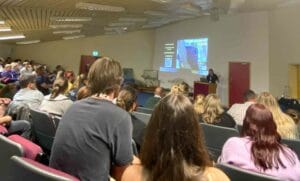With our bags packed and the final checklist done; laptop, satnav, and mascot Amu the sun bear securely buckled into the passenger seat, we departed on what would be an epic 900-mile road-trip across the south and east of the UK. This intensive, week-long tour would feature multiple strategic stops to connect, educate, and collaborate with many animal care professionals and key partner organisations.
I’m Sarah, Wild Welfare’s Animal Welfare Field Manager, and my job is to help bridge the gap between global welfare challenges and practical solutions. Throughout the course of this tour I was aiming to connect with educators, students, animal caregivers and associate partners, whose support and actions are critical for bringing about the positive animal welfare changes we promote.

Sarah presenting at Marwell Zoo Antelope Conference
Our first stop was at the Marwell Zoo Antelope Conference, where we joined over seventy delegates from across the world to talk about the husbandry of these remarkable and endangered species. I had the unique opportunity to address the conference about common welfare issues I’ve witnessed in antelope management at zoos and sanctuaries across the globe. This included notes on husbandry practice challenges in different regions of the world, and what could potentially be learned from these experiences to improve welfare outcomes at other wildlife facilities. It was also a great opportunity to introduce Amu to some new scimitar-horned oryx friends that reside at the zoo!

Sarah and Amu with the class at Plumpton College.
The very next day we were back on the road and heading for Plumpton College in East Sussex, England. I had already provided a virtual talk for the college earlier in the year, however I was particularly excited to meet this class in person to present about “Engagement, Education and Communication in Animal Welfare Reform”. This talk explored the importance of engaging people in our vital work, the key role of good storytelling, barriers to learning about animal care and welfare, our Wild about Welfare Digital Education and a brief introduction to the COM-B model for human behaviour change.

Amu meeting the tortoises at Plumpton college campus.
This particular group were the very first students to partake in the college’s new Applied Zoology and Conservation BSc course. It was wonderful to speak with the eager, reflective, and engaged class, who asked thoughtful questions and showed great interest in the work Wild Welfare conducts globally to improve the lives of wild animals in captive facilities. We had thought-provoking discussions on what animal welfare means to them personally, and how considering cultural differences across countries impacts our approach to welfare reform.
Before hitting the road once again, Will, the lead course lecturer at Plumpton college showed me and Amu around their picturesque campus, where we met tortoises, hornbills and piranhas.
As we left the classrooms behind, the focus of our mission transitioned from teaching and education to that of gratitude and strengthening vital supporter partnerships.

Amu at the Big Cat Sanctuary, UK.
Upon arriving at The Big Cat Sanctuary (BCS) in rural Kent, I seized the opportunity to share exciting updates from our ongoing project work in Borneo. BCS has been a loyal supporter of Wild Welfare since 2021, and our continuing initiative at Lok Kawi Wildlife Park (LKWP) has been made possible by the sanctuary’s kind donations. It was wonderful sharing the history of this important project with their entire team, from animal keepers to the office staff. I introduced them to Diego the sun bear and Hijau the eclectus parrot, both a living testament to all that can be accomplished when collaborating to improve the lives of captive wild animals. Touring the BCS facility, meeting some of their big cats and learning about their rescue stories gave me fresh inspiration for enclosure changes and enrichment designs for some of the same species back in Sabah, such as their clouded leopards. It was a vital reminder that, thanks to our dedicated partners, inspiration flows both ways, driving our shared goal for compassionate care around the globe.

Amu meeting a Cheetah at The Big Cat Sanctuary, Kent, UK.
Heading further eastwards, Amu and I descended on Jimmy’s Farm and Wildlife Park in Ipswich to run two welfare assessment workshops at their keeper upskilling festival known as Keeperfest. It was great to be back after attending in 2024 when I helped to run Wild Welfare’s first ever merchandise stall and gave a talk about dinosaur welfare! This year’s activities were equally exhilarating.
On our return trip home, we stopped off at Hertfordshire Zoo, where I also updated their wonderful team on our work in Malaysia. I spoke in detail about our mentorship-based ‘Partner for Animals’ Programme, which helps to develop collaborations between wildlife facilities through the fostering of mutual animal welfare goals and knowledge sharing. This gives caregivers at progressive zoos the chance to work on-the-ground with a partnered facility to assist with capacity building and strengthening care practices.
We are hugely grateful for the continuing support of the zoo. Their commitment was evident when their Site Plan and Operations Coordinator, Aaron, took the time to provide Amu and me with a fantastic guided tour of their new developments, giving us further ideas for future sun bear enrichment.

Sarah and Amu at Keeperfest working through our Animal Welfare Assessment guidelines with caregivers.
After a 900-mile round trip, I returned home with a warm sense of achievement and connection. Every individual we met, every question answered and every story shared, reminded me precisely why connecting with the individuals working on the frontline of animal care is so vital. Each exchange strengthens our collective understanding and appreciation for ensuring good welfare outcomes for all animals.
Ultimately, our mission is fueled by learning. Whether that knowledge is exchanged through workshops, lectures, or personal discussions, every mile we navigate drives us further toward our goal of ensuring every animal in human care has the opportunity to live a good life worth living.









Discussion about this post